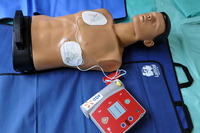Sudden cardiac arrest cases in the Tricity plotted on a map
20.08.2014
Dr Tomasz Łopaciński (MUG Department of Emergency Medicine) spent over 6 months analyzing 500 cases of cardiac arrest in public places (excluding those caused by trauma, hanging, drowning or neoplastic diseases) in the Tricity. He then plotted the locations of those cases onto a map and suggested to place Automatic External Defibrillators (AEDs) in 94 most frequent locations of cardiac arrest. The European Resuscitation Council recommends placing AEDs not only in expected high-risk locations but also in places where a cardiac arrest happened at least once in two years. In his analysis, Dr Łopaciński also focused on the ambulance response times. The average time was 9 minutes, but the response times in Gdańsk were generally slower in Gdańsk than in Gdynia or Sopot.
Dr Łopaciński concluded that the majority of cardiac arrests in public places took place in Gdańsk (65.4%), followed by Gdynia (27.8%) and Sopot (6.8%). The patients were most frequently male (81%) and had an average age of 62 years.
Archives
- Academic Year 2024/2025
- Academic Year 2023/2024
- Academic Year 2022/2023
- Academic Year 2021/2022
- Academic Year 2020/2021
- Academic Year 2019/2020
- Academic Year 2018/2019
- Academic Year 2017/2018
- Academic Year 2016/2017
- Academic Year 2015/2016
- Academic Year 2014/2015
- Academic Year 2013/2014
- Academic Year 2012/2013
